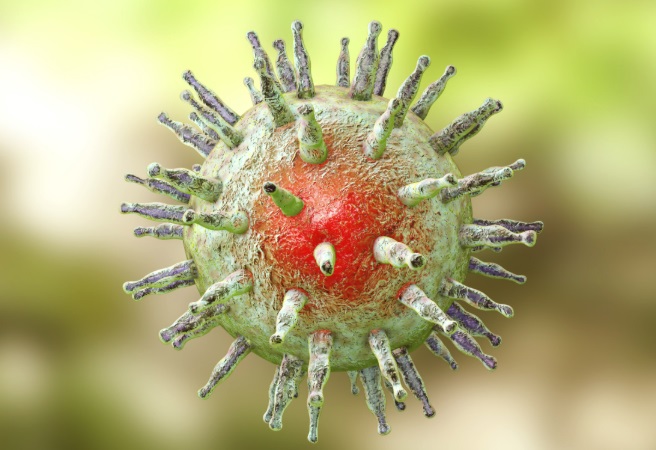Nikhil Prasad Fact checked by:Thailand Medical News Team Jun 27, 2025 3 months, 15 hours, 45 minutes ago
Medical News: New research from scientists at Sharda University in Uttar Pradesh and Max Superspeciality Hospital in New Delhi has uncovered a disturbing link between Long COVID and the reactivation of a hidden virus that infects more than 90% of the world’s population — the Epstein-Barr Virus (EBV). Though EBV often lies dormant, recent studies reveal that it is being awakened in many individuals after a COVID-19 infection, worsening symptoms and possibly prolonging the condition. This
Medical News report examines the detailed mechanisms behind this viral interaction and what it could mean for those suffering months or even years after a SARS-CoV-2 infection.
 Hidden Virus Behind Long COVID Epidemic Could Be Worse Than We Thought!
Hidden Virus Behind Long COVID Epidemic Could Be Worse Than We Thought!
The review, led by Supriya Mahajan and colleagues, compiled clinical and molecular studies showing that EBV reactivation is not only common in Long COVID patients but may also be a key driver of many of the symptoms they experience. This includes fatigue, brain fog, fever, inflammation, immune dysfunction, and even the triggering of autoimmune diseases. In some studies, up to 65% of Long COVID patients showed signs of EBV reactivation. The virus, which remains dormant in B cells, can be pushed back into an active state by SARS-CoV-2 infection, triggering a storm of immune reactions and worsening health outcomes.
How COVID-19 Wakes Up a Sleeping Virus
The Epstein-Barr Virus, part of the herpesvirus family, can remain in a person’s system silently for years. But COVID-19 appears to disturb this dormancy. The reactivation process begins when key viral genes, BZLF1 and BRLF1, are switched on. These genes then trigger the production of viral proteins, which replicate and build new viral particles that are released from the host cell.
Several triggers for EBV reactivation have now been identified. These include not only the stress and immune system disruption caused by SARS-CoV-2 but also the use of certain COVID-19 treatments like remdesivir, azithromycin, and chloroquine. These drugs inadvertently switch on pathways that activate EBV’s viral machinery, such as MAPK and NF-kB signaling.
A Dangerous Two-Way Relationship
The study also found that EBV reactivation can increase the expression of ACE2 receptors, the entry point SARS-CoV-2 uses to infect cells. In other words, EBV may not only be reactivated by COVID-19 but may also help SARS-CoV-2 infect cells more easily. This two-way relationship potentially makes the body more vulnerable to both viruses at once.
The team also highlighted how SARS-CoV-2 proteins interact with human proteins known to be linked to EBV reactivation. For instance, proteins like BRD4, UPF1, and PGE2 are known to either switch on EBV genes or help maintain its life cycle. These host proteins are hijacked during COVID-19, helping reactivate EBV even further.
Inflammation and Autoimmune Disorders Linked to Dual Infection
A major theme in the study is how both viruses — SARS-CoV-2 an
d EBV — feed inflammation. This chronic inflammation not only causes lingering symptoms but may also trigger autoimmune disorders. EBV has long been linked to diseases like multiple sclerosis and lupus. Now, researchers suspect that COVID-19 may amplify these risks by waking up EBV and unleashing it into a hyperinflammatory environment.
Long COVID patients who have EBV reactivation are more likely to show elevated levels of immune molecules like IL-1β, TNF-α, and CXCL10, all of which are also tied to autoimmune flare-ups. Evidence also points to EBV playing a role in multisystem inflammatory syndrome in children (MIS-C) after COVID-19.
Hope for Treatment with Old and New Drugs
The authors identified several drugs that may be repurposed to target EBV reactivation in Long COVID patients. Antivirals such as acyclovir, ganciclovir, and cidofovir — commonly used against herpesviruses — showed potential. Novel compounds like maribavir and EBNA1 inhibitors also demonstrated promise in suppressing EBV’s activity.
Some of these therapies may also help reduce inflammation and COVID-19 symptoms. Acyclovir, for instance, can block key viral pathways, and ibrutinib, originally developed for blood cancers, may calm down immune overactivation caused by EBV and COVID-19 co-infections.
Conclusion
This extensive review sheds light on a hidden contributor to the Long COVID crisis — the Epstein-Barr Virus. The findings suggest that many people struggling with persistent symptoms may not only be dealing with lingering effects of SARS-CoV-2 but also with a reactivated virus that is hijacking their immune system. More importantly, it points toward possible treatment strategies that could improve outcomes for millions. Future research should focus on developing targeted therapies that address both SARS-CoV-2 and EBV to prevent long-term damage and reduce the global burden of Long COVID.
The study findings were published in the peer-reviewed journal: Viruses
https://www.mdpi.com/1999-4915/17/7/903
For the latest COVID-19 News, keep on logging to Thailand
Medical News.
Read Also:
https://www.thailandmedical.news/news/hidden-genetic-flaw-behind-long-covid-lung-damage-exposed-by-dormant-epstein-barr-virus-reactivation
https://www.thailandmedical.news/news/high-prevalence-of-epstein-barr-virus-and-other-viral-markers-found-in-patients-with-chronic-fatigue-syndrome
https://www.thailandmedical.news/news/understanding-how-epstein-barr-virus-leads-to-different-types-of-lymphomas
